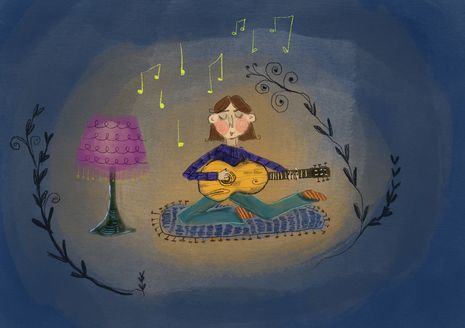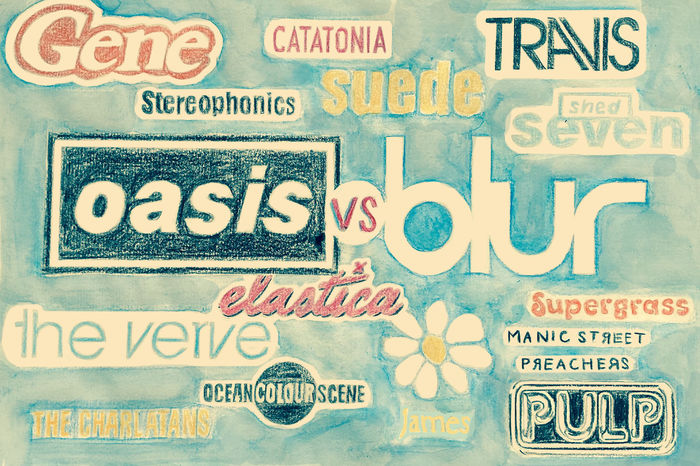When the going gets tough, whip out a guitar
Charlotte Thomann offers her absolute beginner’s guide to songwriting

We used to spend whole days entertaining ourselves through our imagination: creating magical universes, animating dolls with storylines, drawing. Yet, after a long week of juggling a never-ending supply of deadlines with your social life, creative pursuits often end up on the backburner. After all, why should you extend your already fried brain to create when you can consume? An infinite world of possibility lies behind two clicks of a screen. But those mind-numbing pursuits leave you hungry, addicted, and disconnected to your own thoughts. This is why I am proposing songwriting as a better way to survive future week five blues.
Step 1: Accept the idea that you are about to write a song
You might be wondering, why me? Who do I think I am, creating a song when there is already so much good music out there? And the scariest thought of all: what if it’s completely crap and I have to spend the rest of my life in hiding – will I ever be able to show my face at Frash again? Fear not, for I think the best way to start writing is under the assumption that it will be crap. Just accept it and move on. You are not writing for friends, family and least of all your judgy supo partner. You are writing to record something that is completely and utterly you. Isn’t that mindbogglingly wonderful?
“Will I ever be able to show my face at Frash again?”
Step 2: Find a starting point
Grab your phone and open the notes app (or, if you’re feeling classy, a sheet of parchment paper and a quill). I like to start with whatever I’m currently obsessing over. This could be anything from how much you miss Gardies to the FOMO you feel when your friend finds the love of their life on Hinge, while you struggle to sit in the same room as your crush. A real trade secret here: it doesn’t even have to be real. Why not imagine how it would feel to be Conrad after Belly shattered his heart at the beach house? Just make sure you know the who, what, where, when, and why.
Step 3: Pick a chord progression
No musical experience? No problem! Just google random chord generators and play around until you hear something you like. If you play an instrument, that’s great, too! Choose a chord progression that matches the vibe of your idea. I personally like to use C/G/Am/F for happy songs and Am/F/C/G for sadder ones, as they are easy and versatile.
“No musical experience? No problem!”
Step 4: Chord looping until something sticks
Congratulations if you have made it this far! This is where the magic begins, and the musical gods reach out to bless your soul with their holy tunes. Just kidding – nothing magical about this, just you playing the chords on repeat while humming over them. Think of it as coming up with a jingle, and keep at it until something that sounds good to you comes out. As soon as this happens, start recording a voice memo, otherwise you’ll forget (speaking from experience). Try not to obsess over sounding like Bob Dylan – this will just create a mental block. It’s always better to sound terrible but original – who knows, maybe someone will love your terrible!
Step 5: Get writing!
You have a short melody, your chords, and even your inspiration! Now all you have to do is make the vision fit the tune. An easy way to do this is to sing your melody in gibberish over the chords. Even the Beatles used nonsense words – believe it or not, the original ‘Something’ lyrics were: “something in the way she moves attracts me like a pomegranate”. Just stick to your gut and don’t stress about coming up with rhymes, you’d be surprised by how many English words end in ‘y’. Regardless, whether your lyrics are avant garde or diaristic, try not to get caught up with sounding too poetic – Taylor Swift has made billions from being honest and to the point.
Step 6: Tie it all together
Now that you have a musical phrase – it could be a verse, chorus, bridge, or something else – repeat the process for the other parts of a song. Lots of popular music use the verse, prechorus, chorus, verse, prechorus chorus, bridge, outro structure, but it’s completely up to you if you decide to stick to this or go in a new direction.
Who knew you could do that! It almost looks like… you could be an artist? I hope you had fun and have realised that you don’t have to be in Paul McCartney’s subconscious to make something out of nothing.
P.S. If you want to explore this even further, these videos by Nena Shelby and Annie Dang are a great place to start.
 News / Cambridge cosies up to Reform UK30 November 2025
News / Cambridge cosies up to Reform UK30 November 2025 News / University Centre hangs in the balance28 November 2025
News / University Centre hangs in the balance28 November 2025 News / Jack Peters wins Union presidency in contested race1 December 2025
News / Jack Peters wins Union presidency in contested race1 December 2025 News / Protesters accuse sustainability institute of ‘greenwashing’1 December 2025
News / Protesters accuse sustainability institute of ‘greenwashing’1 December 2025 News / Uni registers controversial new women’s society28 November 2025
News / Uni registers controversial new women’s society28 November 2025










